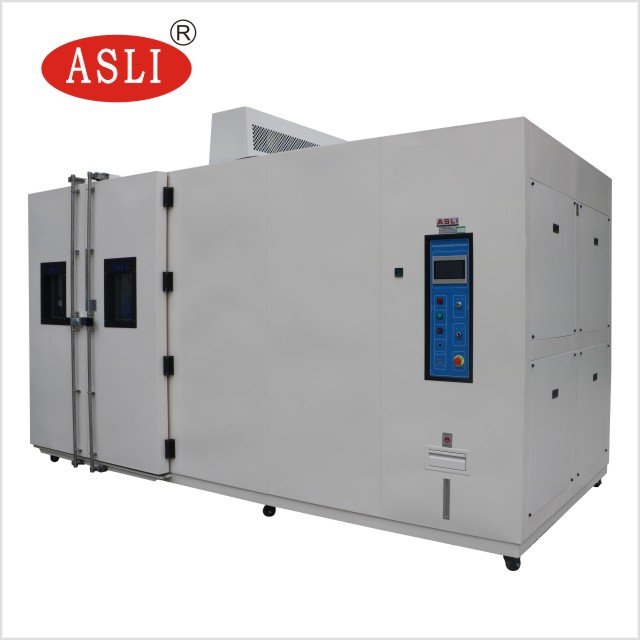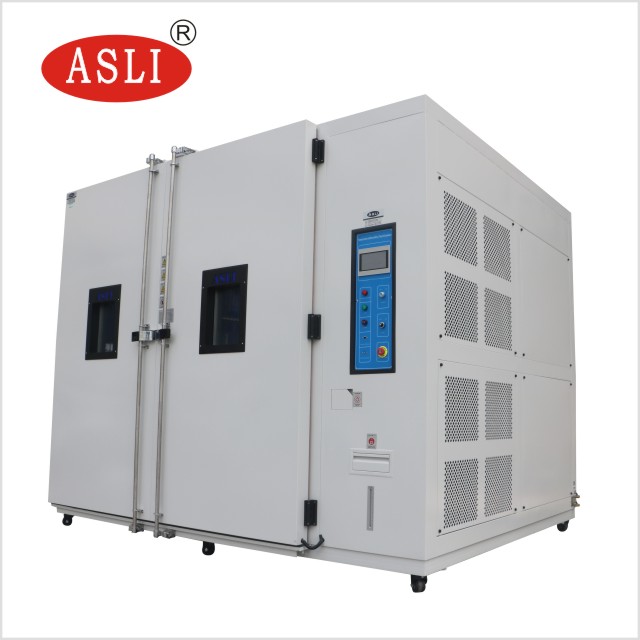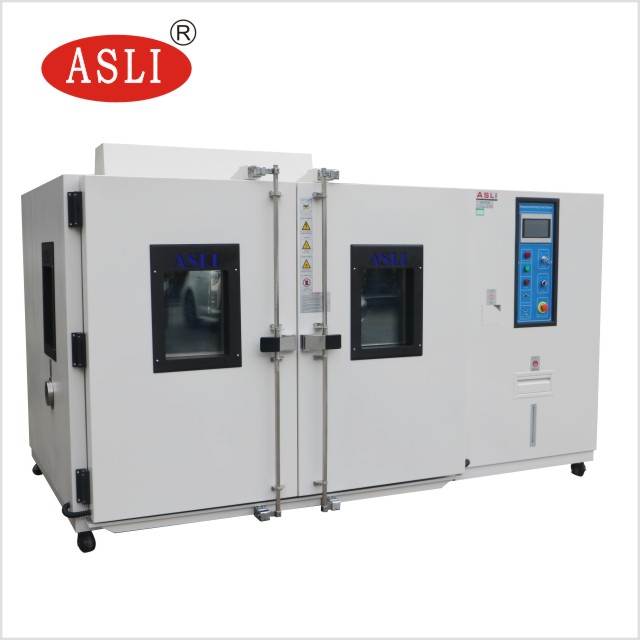In the realm of product testing and quality assurance, the walk-in temperature humidity test chamber stands as a pivotal tool, especially for industries handling large-scale items or high-volume batches. This guide aims to elucidate the complex mechanics behind these chambers, exploring their diverse applications from aerospace components to consumer electronics. By dissecting the structural nuances and operational protocols, the discussion will extend into how these chambers meet rigorous compliance standards and what makes them indispensable for ensuring product resilience against environmental stresses. As we proceed, one might ponder the implications of these technologies on future product development and industry standards.
A walk-in temperature humidity test chamber is an expansive type of climate simulation equipment designed to accommodate large items or batches of materials that require environmental condition testing. These chambers are integral to evaluating how products withstand adverse conditions, simulating a wide range of temperature and humidity scenarios. This capability is essential for determining the resilience and longevity of products, highlighting the importance of environmental simulation in product durability testing.
The use of walk-in chambers offers significant test chamber benefits by providing a controlled, homogeneous environment necessary for precise climate condition assessments. This climate control technology ensures that every part of the test specimen experiences the same conditions simultaneously, thereby guaranteeing consistent results across the entire batch.
The ability to simulate and control these temperature humidity effects is crucial for industries where product quality and durability are paramount.
Furthermore, the scale and versatility of walk-in temperature humidity test chambers make them indispensable for comprehensive testing procedures. They play a pivotal role in product development and quality assurance processes, ensuring that products are capable of performing under the most demanding conditions, which ultimately supports product reliability and consumer trust.
Several key components define the structure and function of a walk-in temperature humidity test chamber, each meticulously designed to achieve and maintain precise environmental conditions. Central to these chambers are the dew point bath and heating mechanisms that finely adjust the chamber's atmosphere to specific temperature and humidity levels.
For instance, if a climate of 40°C with 75% relative humidity is needed, the system initially regulates the air to a saturated 34.9°C, then heats it slightly to achieve the desired humidity reduction.
The chambers are built with robust insulation materials that not only help in maintaining the internal climate but also ensure operational efficiency and stability. External placement of the climate control unit simplifies maintenance and minimizes internal disturbances, reinforcing the chamber's capability to consistently replicate specified environmental conditions.
To further illustrate the sophistication of these chambers:
These features collectively enhance the precision, reliability, and utility of walk-in temperature humidity test chambers, ensuring they meet the exacting demands of specialized applications.

Walk-in temperature humidity test chambers serve a wide array of applications across various industries, underpinning their versatility and essential role in product development and quality assurance.
These chambers are pivotal in maintaining rigorous temperature control and humidity regulation, crucial for testing protocols in sectors such as pharmaceuticals, food, cosmetics, and electronics.
In the pharmaceutical and life sciences sectors, walk-in chambers facilitate stability and aging tests, ensuring that products like vaccines and medications meet stringent safety standards before reaching consumers.
The chamber design allows for precise control over environmental conditions, critical for stability testing and microbiological studies.
The food industry benefits significantly from these chambers through accelerated shelf-life testing. By simulating various environmental conditions, manufacturers can predict how products will withstand different climates, enhancing food safety and quality.
Similarly, in cosmetics, stability testing under controlled temperature and humidity conditions ensures that products maintain their efficacy and safety over time.
Additionally, these chambers are used in more specialized applications such as altitude simulation, vibration integration, and solar simulation, demonstrating their critical role in tailoring testing environments to specific regulatory and application industry needs.
Understanding the operational mechanics of walk-in temperature humidity test chambers is key to appreciating their efficacy in diverse industry applications. These chambers create a controlled environment crucial for simulating various temperature and humidity conditions, essential for environmental simulation and testing protocols.
The precision in temperature stability is managed through integrated heating and cooling systems that adjust the internal climate based on real-time sensor data. Humidity calibration involves both humidification and dehumidification systems, ensuring the chamber maintains specific moisture levels critical for accurate test results.
To enhance your understanding, consider these key components:
Regular chamber maintenance is vital to sustain operational integrity and accuracy. This systematic approach to controlling environmental conditions makes these chambers indispensable in sectors requiring stringent quality checks, such as pharmaceuticals, electronics, and automotive manufacturing.
Compliance with established standards is crucial when operating walk-in temperature humidity test chambers, as these standards ensure that the chambers perform safely and effectively across various industries. Adherence to these regulations not only supports regulatory compliance but also enhances data integrity and the reliability of environmental testing outcomes.
| Standard | Description | Relevance |
|---|---|---|
| GB/T2423.1-2001 | Low-temperature testing methods. | Ensures precise control and calibration procedures. |
| IEC60068-2-2 | High-temperature testing methods. | Critical for environmental testing accuracy. |
| GJB150.9 | Humidity test standards. | Essential for maintaining data integrity in testing. |
| ASTM F1980 | Accelerated aging of medical devices. | Guides chamber maintenance and testing protocols. |
Effective operation of these chambers demands rigorous calibration procedures that align with standards like GB/T2423.2-2001 for high-temperature testing, ensuring that all components meet necessary specifications. Chamber maintenance is vital to sustain operational efficiency and compliance with standards such as ICH Q1A for pharmaceutical stability testing. This comprehensive approach to regulatory adherence not only supports the accuracy and reliability of tests but also secures the integrity and usability of the data produced, crucial for ongoing advancements in product development and quality assurance.
Innovative design and advanced technological integration set the stage for the key features and benefits of walk-in temperature humidity test chambers. These chambers are crafted to meet the stringent requirements of diverse industries, ensuring precise environmental simulations without compromising on functionality.
Key features include:
These chambers not only provide robust temperature control but also incorporate extensive safety features, such as multi-level access controls and heavy-duty locks, ensuring secure and reliable operation.
The combination of these advanced features results in a powerful tool that enhances productivity, ensures safety, and maintains energy efficiency, making it an ideal choice for rigorous environmental testing.
Building on the extensive features highlighted earlier, the walk-in temperature humidity test chamber offers a range of models and specifications tailored to meet diverse testing needs. Each model, labeled from A to F, provides a specific low-temperature option ranging from 25°C to -70°C, with the capability to reach up to 150°C as a high-temperature option. This adaptability ensures precise temperature calibration for various environmental conditions.
The chamber's interior can be customized according to designated space sizes, aligning with specific testing protocols and requirements. Humidity control is finely tuned, with a range from 20% to 98% R.H., and optional conditions down to 5% R.H., facilitated by an additional dehumidifier. This level of control allows for stringent humidity regulation essential for reliable testing outcomes.
Chamber maintenance is streamlined through integrated protection devices such as fuse-free switches and various safety cutoffs, ensuring longevity and consistent performance. The cooling system employs energy-efficient components like the French Tecumseh or German Bizer brand compressors, optimizing operational costs.
Moreover, the uniformity and accuracy in controlling temperature and humidity are maintained within tight tolerances, crucial for meeting rigorous testing standards and enhancing the chamber's overall energy efficiency.
Several industries, ranging from aerospace to pharmaceuticals, rely on Walk-In and Drive-In test chambers to simulate various environmental conditions that machinery, materials, devices, or components might encounter.
These chambers are pivotal in ensuring that products function optimally under harsh conditions and meet stringent industry standards, underlining the importance of environmental testing. Weiss Technik's offerings in both Walk-In and Drive-In chambers are renowned for their adaptability and precision in replicating environmental stresses such as temperature fluctuations and humidity extremes.
These features collectively enhance the reliability and precision of environmental simulations, ensuring that products are not only compliant but also capable of withstanding real-world conditions.



Having explored the advanced features and configurations of Walk-In and Drive-In chambers by Weiss Technik, it is equally important to understand how to select the right Walk-In Temperature Humidity Test Chamber that aligns with specific testing requirements and budget considerations.
When it comes to chamber selection tips, first consider the temperature and humidity range necessary for your products, ensuring the chamber provides a buffer to accommodate future needs.
Assess chamber volume and size to ensure it supports your products while fitting within your available space.
Control accuracy and uniformity are crucial; verify the chamber's ability to maintain precise temperature and humidity levels consistently across its volume.
Regarding temperature calibration techniques and humidity control methods, prioritize chambers that offer advanced solutions to manage these variables effectively.
When evaluating manufacturer comparison criteria, investigate the manufacturer's reputation, focusing on customer reviews, industry recognition, and the quality of after-sales support, including warranty and technical assistance.
Testing budget considerations should include not only the initial purchase price but also long-term operating costs, such as maintenance and energy consumption.
Thorough research and comparison will guide you to a chamber that meets your specific testing needs and budget.

Operating a Walk-In Temperature and Humidity Environmental Test Chamber requires stringent safety precautions to prevent any potential hazards. This specialized equipment, often referred to as constant temperature and humidity chambers, plays a critical role in testing environmental resistance of materials. Its complexity and the environment it creates necessitate a controlled and knowledgeable approach to operation.
To enhance understanding and engagement, consider the following key points:
Adhering to these safety measures, along with rigorous environmental controls, ensures the reliable operation of the walk-in chambers and safeguards both the integrity of the experimental data and the well-being of the operators.
Yes, mobile walk-in chambers are available, offering benefits like enhanced field testing efficiency. These portable chamber designs feature advanced temperature control and humidity testing accuracy, optimizing conditions directly at varied, remote testing sites.
Walk-in chamber calibration should adhere to maintenance protocols, ensuring environmental stability and meeting accuracy standards. Calibration frequency typically aligns with testing intervals, but annual checks are recommended to maintain control over performance variables.
Energy consumption rates of these chambers vary based on power requirements, usage guidelines, and maintenance practices. Optimizing energy efficiency can significantly reduce operational costs, making adherence to manufacturer specifications crucial for cost-effective control.
Yes, walk-in chambers offer customization options to accommodate specific test protocols. Design flexibility allows for various chamber sizes and configurations that align with distinct testing standards, ensuring precise control over environmental conditions.
In conclusion, walk-in temperature humidity test chambers represent a critical juncture between innovation and reliability, juxtaposing the expansive capacity to accommodate large-scale items with the precision required for stringent environmental testing. Industries adopting these chambers stand at the forefront of quality assurance, ensuring products withstand diverse climatic conditions. This integration of robust testing with meticulous standard compliance is indispensable for maintaining consumer trust and cementing product integrity in a competitive market.
Founded in 1988, ASLI (China) Test Equipment Co., Ltd. produces high-quality inspection instruments and testing equipment, including temperature and humidity chambers, aging testers, and vibration testers. Certified to international standards, ASLI serves research, quality inspection, and educational sectors worldwide, renowned for precision, reliability, and exceptional customer service.
Contact us for a free quote of your ideal walk in temperature humidity test chamber!

